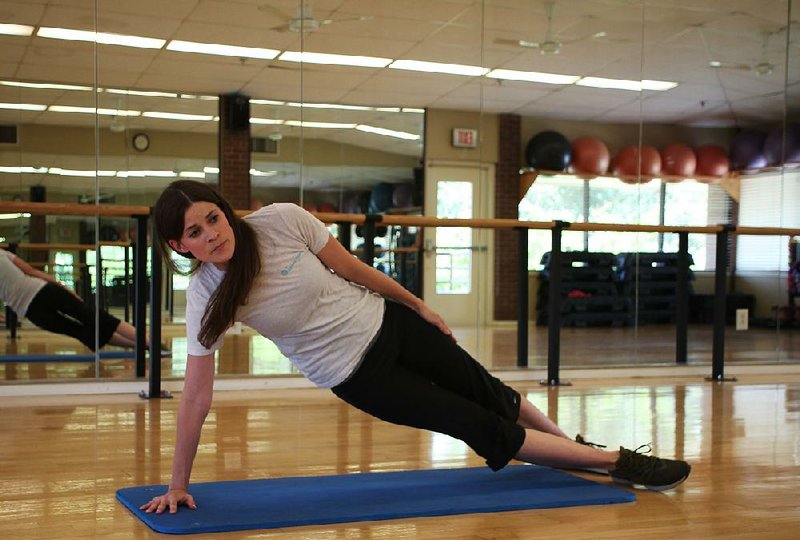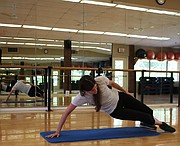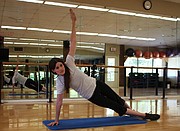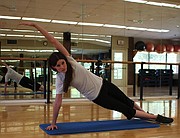Summertime workouts can be difficult to maintain, especially as the weather is sweltering and temperatures keep on rising. In these conditions, outdoor exercise seems unappealing at best and outright dangerous at worst. There are some key strategies, however, that improve one's chances of not only maintaining an outdoor workout program all summer -- but doing so safely. This week, I'll discuss a few of those strategies and will introduce an exercise that makes a perfect addition to an outdoor workout.
Growing up in a small town in southeast Kansas, I can vividly remember participating in "two-a-day" high school football practices in mid-August. We had one practice around 8 a.m. and another around 4 p.m., but both were brutal tests of endurance as buckets of sweat poured off our uniforms. More than a few players experienced what I now know to be heat exhaustion, and times have certainly changed as coaches have become more educated about temperature, exercise and their responsibility to protect the health of young athletes.
Fortunately for us, no one experienced any serious medical problems as a result of practicing in full pads in 100-plus degree heat. Other programs haven't been as fortunate. On average, three football players die every year from heat-related health complications. But heat and humidity affects everyone, and regular exercisers need to take steps to prevent heat exhaustion or heat stroke from occurring.
There are four key variables that should be addressed before exercising outdoors. They are: education, acclimatization, attire and hydration. First, take a look at the combination of temperature and relative humidity. Heat stroke can occur with temperature above 80 degrees and relative humidity above 40%. In the Midwest, our summers feature temperature and humidity combinations in excess of these limits as early as May. So, I recommend keeping a printout of the NOAA National Weather Service Heat Index Chart (www.weather.gov/safety/heat-index). This chart shows various combinations of temperature and humidity, then ranks them in terms of health risks associated with exposure. According to the NOAA, any heat/humidity combination greater than 126 should be approached with extreme caution.
Assuming the NOAA head index is taken into consideration, preparing one's body for exercise in the heat is also important. Acclimatization, proper clothing and hydration are all key factors influencing one's ability to successfully exercise in hot conditions without problems.
Acclimatization is really about giving your body time to adjust to exercising in the heat. Start with short bouts of activity, maybe 15-20 minutes at a time. As your body begins to acclimatize, you'll be able to extend exercise periods. Clothing is also important. Breathable, moisture-wicking material is a key part of keeping the body cool -- but lighter colors will repel the heat while darker colors absorb it. Finally, remember to drink lots of water and replenish electrolytes with a nonsugary beverage.
Exercise choice matters, as well. Strenuous activity such as fast running increases heart rate, perspiration rate and escalates the rate that heat affects the body. It's important to mix in lower intensity activities (in the shade if possible) to ensure the body has a chance to cool down frequently.
This week's exercise is the perfect cool-down movement when exercising outdoors. The Side Plank Windmill is a low intensity movement that strengthens the core through a simple movement that can be performed almost anywhere, as long as a flat surface is available.
Place an exercise mat on the floor. If outside, grass is fine. Lie on your right side.
Now, place the right hand on the mat and lift up your torso so that you're in the side plank position balancing only on your right hand and your feet (both feet should be touching the floor) with the legs fully extended. Your left arm should be resting at your side.
From here, bend both knees and squat down until your hips get close to your feet, but without touching them to the floor.
Extend the legs straight again, and also raise your left arm over your head simultaneously in a "windmill" arc.
Continue performing these reps continuously until you've done 12 on the right side.
Switch sides and repeat.
Age and health status also affect one's ability to exercise in the heat, so it's important to really understand your limitations. The tips and techniques outlined in this article are general guidelines, but there's no substitute for common sense. If you feel lightheaded, thirsty and overheated -- it's time to head indoors. After all, no workout is worth experiencing heat-related illness -- so maybe crank up that elliptical machine in the basement on extra hot days. Enjoy!
Matt Parrott has a doctorate in education (sport studies) and a master's in kinesiology and is certified by the American College of Sports Medicine.
ActiveStyle on 07/22/2019




